Geopora arenicola (Lév.) Kers
Phylum: Ascomycota - Class: Pezizomycetes - Order: Pezizales - Family: Pyronemataceae
Distribution - Taxonomic History - Etymology - Toxicity - Identification - Reference Sources
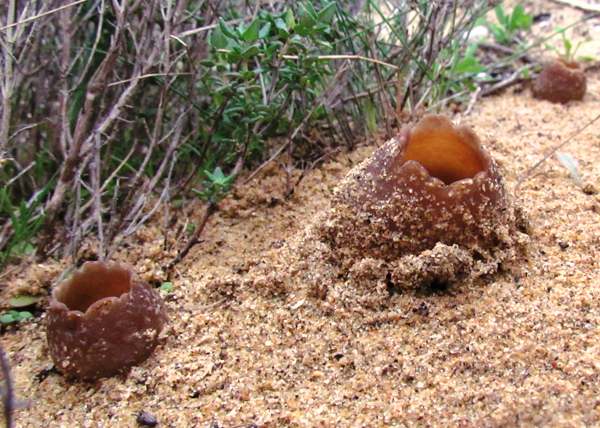
This attractive little cup fungus of dry, sandy sites and occasionally also places where wood has been burned on dry light soil develops initially as an underground sphere before breaking through the surface and opening up to form a crown-shaped cup. In some areas Geopora arenicola is fairly common in sand dunes, where it appears close to low-growing shrubs.
Pictures on this page were taken in coastal dunes near Aljezir, in the Western Algarve, Portugal.
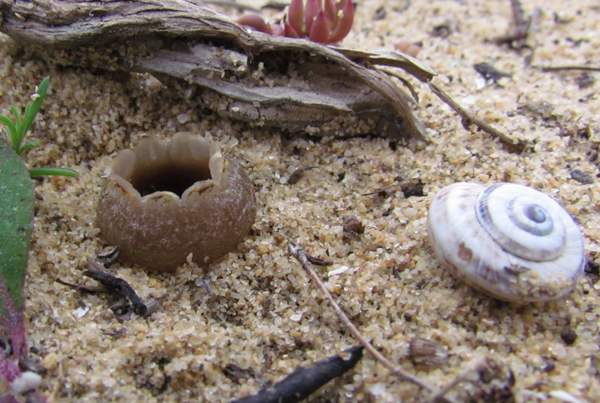
Distribution
Geopora arenicola is an ascomycetous cup fungus, and it is most common in central and southern Europe, where is quite often found in sand dunes or beside reservoirs created from sand extraction.
Geopora arenicola is a rare find in Britain. Many of the officially recorded finds are from sandy coastal sites in southern England (although it has been recorded as far north as Yorkshire) and in the sand dune systems around the coast of Wales.
Taxonomic history
Originally described in 1848 by French mycologist Joseph-Henri Léveillé (1796 - 1870) and named Peziza arenicola, this cup fungus was for many years known as Sepultaria arenicola, a name given to it in 1887 by William Phillips (1822 - 1905). Its present accepted name, Geopora arenicola, comes from an 1895 publication by George Edward Massee (1850 - 1917), co-founder and first president of the British Mycological Society.
Synonyms of Geopora arenicola include Sepultaria arenicola (Lév.) Massee, and Peziza bloxamii Cooke.
Etymology
The generic name Geopora means earth cup, appropriate for cup fungi that grow on/in earth, while the specific epithet arenicola means 'of sand'. The synonymous generic name Sepultaria means underground tomb, and as the cup fungi in this group develop underground and are usually more than half buried even when the cups have opened, the reference seems entirely appropriate.
Toxicity
Poisonous if eaten raw, Geopora arenicola may be toxic even if cooked. In any case the flesh is insubstantial and, in view of the relative rarity of these cup fungi in many areas, it would seem irresponsible to gather them.
Identification Guide
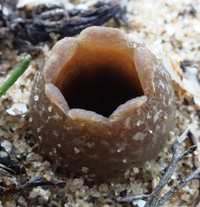 |
Fertile (inner) surfacePale cream to greyish beige on the smooth inner (hymenial or spore-bearing) surface, fruitbodies of Geopora arenicola develop over several months as underground spheres before breaking through the surface of the soil and splitting open in the form of typically 5 to 7 fairly regular rays. Up to 2.5cm tall, the cups are typically 1 to 2.5cm across when fully open. Like most cup fungi the flesh of Geopora arenicola is quite brittle. |
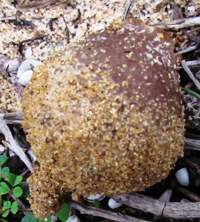 |
Infertile (outer) surface and stemVarying in colour from pale-brown to mid-brown, the scurfy outer surface is infertile and is covered in microscopic light-brown hairs. (The spores are produced on the shiny inner surface of the cup.) |
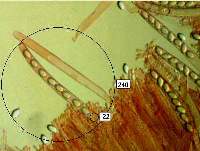 |
AsciTypically 300µm x 22 µm, with eight spores per ascus. |
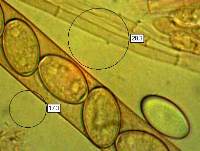 |
SporesEllipsoidal-fusiform, smooth, typically 27 x 16µm; each usually containing either one or two large oil drops and a number of small ones. Spore printWhite. |
Odour/taste |
Not distinctive. |
Habitat & Ecological role |
On sandy soil, often in coastal sand dune systems. Geopora species are thought to be mycorrhizal with various shrubs, but it is reportedly very difficult to determine with certainty the species involved. |
Season |
These cups can appear any time from spring through to autumn, but in Britain they are most commonly seen between September and November. |
Similar species |
Geopora arenosa is virtually indistinguishable macroscopically from Geopora areniciola, and it also appears in dry sandy places, most particularly on sand dune systems. The spores of Geopora arenosa are smaller at 22-25 x 11-15µm compared with 24-28 x 12-16µm for Geopora arenicola. (Not surprisingly, some authorities treat these two species as synonymous.) Geopora sumneriana has a more hairy outer surface and grows exclusively (or almost so) under cedar trees (Cedrus spp.). Sarcoscypha austriaca, the Scarlet Elf Cup, is bright red and grows on dead twigs and branches, in mossy woods and sometimes under damp hedgerows. |
Reference Sources
Fascinated by Fungi, 2nd Edition, Pat O'Reilly 2016, reprinted by Coch-y-bonddu Books in 2022.
Dennis, R.W.G. (1981). British Ascomycetes; Lubrecht & Cramer; ISBN: 3768205525.
Breitenbach, J. & Kränzlin, F. (1984). Fungi of Switzerland. Volume 1: Ascomycetes. Verlag Mykologia: Luzern, Switzerland.
Medardi, G. (2006). Ascomiceti d'Italia. Centro Studi Micologici: Trento.
Dictionary of the Fungi; Paul M. Kirk, Paul F. Cannon, David W. Minter and J. A. Stalpers; CABI, 2008
Taxonomic history and synonym information on these pages is drawn from many sources but in particular from the British Mycological Society's GB Checklist of Fungi.
Fascinated by Fungi. Back by popular demand, Pat O'Reilly's best-selling 450-page hardback book is available now. The latest second edition was republished with a sparkling new cover design in September 2022 by Coch-y-Bonddu Books. Full details and copies are available from the publisher's online bookshop...

